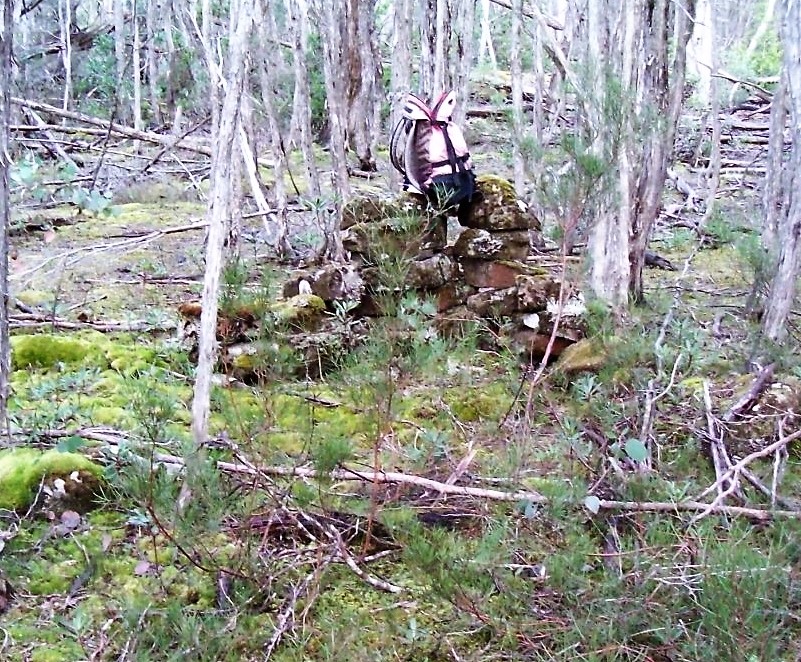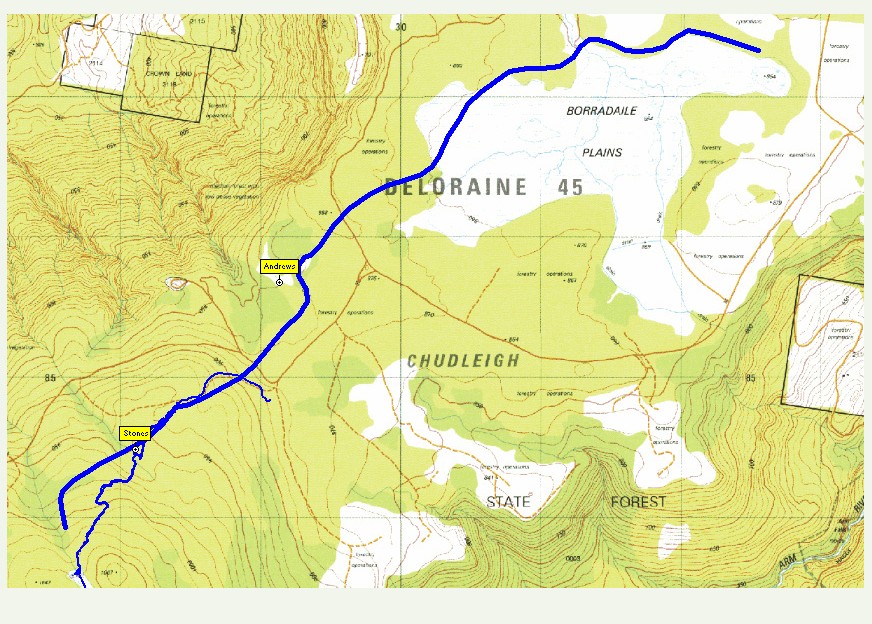In Mountain Stories Blog on 4 May 2015 Simon Cubit described a mysterious pile of stones near the February Plains. There wasn’t much to say about this anonymous heap of rocks. Simon wanted to know more. Ian Hayes and I knew nothing of their history but Simon’s interest lodged in the back of our minds. It has taken two years but the mystery is solved.

The rocks are in a young tea-tree thicket in a bog near the track up to the first of Basil Steer’s February Plains Huts. They are a pretty rough arrangement and there is nothing obvious to show what they are. Apparently no stumps nearby that you’d expect if it was a hut and no rusting artefacts on the ground. That was all we knew until June 2017.
If you were up amongst the tea-trees on Tuesday 15th March 1898 you would be pleased to have this pile of rocks. The weather was bad. Frederick Prichard, the editor of the Launceston Examiner, said that ‘it was blowing a heavy westerly gale, with heavy scud flying over head’.[1] The wind was howling in the tree tops. Prichard was out to report on the construction of the Mole Creek Track. He and the photographer Stephen Spurling III waited at a hut for Philip Parsons (prospector, packer and guide) and his two helpers, Knowles and Wilson, to arrive with their pack horses. Henry Chalmers, the troublesome local surveyor, had just left after retrieving some of his surveying instruments from the hut. It seems that he carried them for affect because he didn’t use them correctly.

Prichard said that the hut was built years earlier by ‘Jerry’ Aylett (William Aylett senior). The hut was rough. He said it ‘was not too luxurious, a double bunk and a single but it was dry’. He described it; ‘as usual, a log structure, about 16 by 10 (feet) with a narrow hole for a door.’ The hut was ‘ensconced amongst some tea tree, (just as we find it today) which shelters it from the south and west, and has some nice grass land around it.’ Prichard and Spurling boiled the billy as they waited but the water was ‘bad, an unusual occurrence’. Parsons found better when he returned.
They had a hearty dinner, smoked their pipes and told a few yarns and were soon asleep. The next morning, they set off early but the weather on the open February Plains was so bad that the horses refused to face into it. The group returned to the protection of Aylett’s hut.
Jerry Aylett was using the camp in 1892 when local correspondent for the North Coast Standard ‘Jasper’ went out with Richard How to see the new silver mines on the Pelion Plains.[2] About three kilometres beyond the Borradaile Plains he entered ‘a small well sheltered plain’ where he found the ‘cosy bark hut’ belonging to ‘veritable old hunter and bushman Jerry Aylett’. Aylett wasn’t far away because the hut was decorated with the carcasses of a possum, wallaby and native cat.
The hut was gone by 1908 when Harry Andrews took up his selection further down the hill and nearer to the Borradaile Plains. It fell out of any recorded history but it was still remembered by the local community. Basil Steers knew the location and its history. He described ‘Bill Aylett’s’ snarer’s hut as ‘under the foot of the February where the hill starts to rise. There is a plain there … where that bit of a clearing is, it would be a good place to get some waratahs … There is still a post there’[3]. This comment in Basil’s list of huts that he made for Ned Terry was essential. He made a distinction between Harry Andrew’s hut and Jerry Aylett’s and described the location. Otherwise we would still be thinking that Aylett’s hut was where Andrew’s was later built.
History tells us that Jerry Aylett built a hut somewhere on the northern edge of the February Plains but physical remains tell us much more. In June 2017 Ian Hayes and I were exploring the old cattle track and realised that the half-forgotten pile of stones was very close to it. The current track to the February Plains is further away.

University of Tasmania 1956 and Tasmap)
In front of the rocks, actually the old fire-place, is a small patch of vegetation that is different to all the other around it. It may be charcoal or the rotting timbers of the long gone hut that still leave their ghostly mark on the soil. The shape actually tells us that the hut collapsed sideways.
Ian and David Von Stieglitz went back and followed the old track, now almost invisible and found a small group of old stumps. The stumps were protected from the bushfires that have swept this area by being at the edge of the wet ground. They are the remains of the trees that became the logs and bark that made Jerry Aylett’s hut almost 130 years ago. The stumps meant that another piece of the fragile old jigsaw fell into place. It was also clear that there wasn’t a single nail or metal object at the hut site, something that supports the hut being made of logs rather than nailed palings
In the end all we had to do was combine the information from the written and oral histories with the physical remains. The answer had been there the whole time. The ‘mystery arrangement of stones’ are all is left of William Aylett’s old hunting hut.
Peter Brown and Ian Hayes
Copyright: MountainStories.net.au 2018
[1] F Prichard, The Mole Creek Track Our Special No.2, Launceston Examiner, 23 March 1898, page 5
[2] Jasper, ‘A Trip to the Interior’ The North Coast Standard, 24 February 1892 p 2
[3] Ned Terry, Identities and History of Tasmania’s High Country, 2005, page 44
In the area at week will have to look for it.